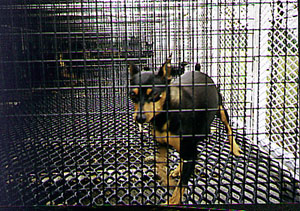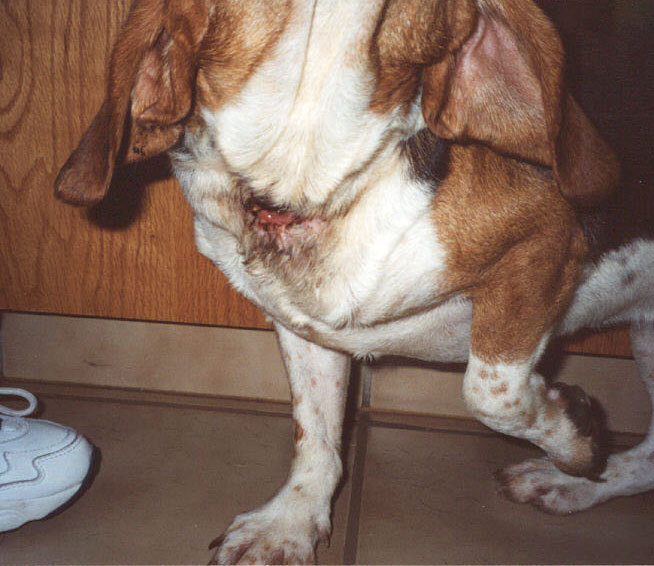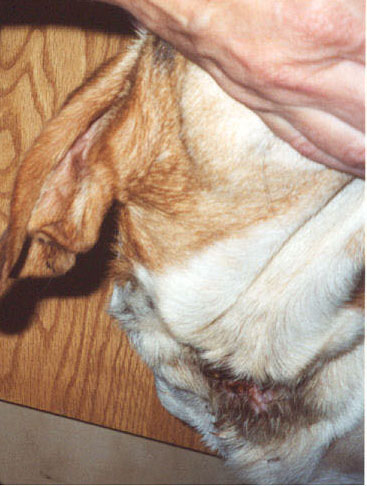
Adopting The PuppyMill Survivor As
society grows more conscious of animal abuse and neglect, we read
nearly every day about a puppymill being closed down and the animals
confiscated. Many times these animals are in deplorable physical
condition: parasite-ridden, underweight, bred nearly to death. Most
have rarely been out of their small, cramped cages. They may have
eye infections, missing orbs or vision impairment caused by ammonia
from urine-soaked quarters. Some have torn, deformed ears and
missing limbs from cage aggression. Females may have hernias from
painful, extended labor. Their toes may be splayed from walking on
wire floors. Many have tattooed ears. Some have numbers hung around
their necks on chains that have grown into their flesh. Their dental
state is invariably horrible; most will have painful, infected teeth
and gums, some resulting in systemic infections. As
society grows more conscious of animal abuse and neglect, we read
nearly every day about a puppymill being closed down and the animals
confiscated. Many times these animals are in deplorable physical
condition: parasite-ridden, underweight, bred nearly to death. Most
have rarely been out of their small, cramped cages. They may have
eye infections, missing orbs or vision impairment caused by ammonia
from urine-soaked quarters. Some have torn, deformed ears and
missing limbs from cage aggression. Females may have hernias from
painful, extended labor. Their toes may be splayed from walking on
wire floors. Many have tattooed ears. Some have numbers hung around
their necks on chains that have grown into their flesh. Their dental
state is invariably horrible; most will have painful, infected teeth
and gums, some resulting in systemic infections. These are animals who've endured years of torture to make money for
uncaring humans.
These are animals who've endured years of torture to make money for
uncaring humans.When a reputable rescuer gets her hands on a puppymill survivor, providing medical attention is just the beginning. The physical damage can be staggering. The psychological damage is much worse. It takes a very special adopter to accept and love a puppymill survivor. Rehabilitation of the puppymill survivor begins with rescue, but can only be completed by a committed, loving family. The purpose of this article is to help demystify some of the acquired behaviors of the puppymill dog, and to let the adopter know what to expect. Common Puppymill Survivor Behaviors  Terror
of humans hands: The only time most mill dogs are removed from their
cages, it's a painful experience. The dog may be grabbed by the
first reachable part of it's body: tail, leg, scruff, ears. This
takes lots of patience and non-threatening touches to overcome. Terror
of humans hands: The only time most mill dogs are removed from their
cages, it's a painful experience. The dog may be grabbed by the
first reachable part of it's body: tail, leg, scruff, ears. This
takes lots of patience and non-threatening touches to overcome. You may have to lie on the floor face down with your eyes averted to get the dog to approach you at all. Let him come near you and sniff. It may take an hour, or days for this to happen. You can sometimes begin by holding the dog, petting him gently for a few seconds, speaking softly, then place him carefully down. Let him know you do not wish to restrain him. Lengthen the time for this ritual each day. Never raise your voice, clap your hands, or allow loud noises in the home during this adjustment period. You must strive to create a totally non-threatening environment. Behave as submissively as possible. Build trust slowly. Aversion To Eye Contact: Many puppymill survivors refuse to make eye contact with humans. This indicates fearful submission which decreases as the dog comes to realize he will not be harmed by you and begins to trust. Talking to your dog in a soft, calm voice helps speed the process. A dog may not speak English, but the gentle tone of your voice and the fact that he is the focus of your concern will be understood. The "I'm Afraid Of My Food" Routine: Anytime the cage door is opened on a mill dog, fear is the response, because an evil human is behind it. Of course, the cage door must be opened to insert a bowl of food, which may also be used to entice the dog within reach. It's not unusual to see your puppymill survivor run in the opposite direction when you sit dinner on the floor. Turn your back and walk away until the dog feels "safe" enough to eat. Let him eat undisturbed. Marking/Housetraining: No puppymill survivor comes housetrained. Some never grasp the finer points. Most males will mark, and many females, too. Crates are useful in housetraining. Belly bands (a cloth band which wraps around male dogs covering the ureter) will help prevent marking. Nicely fitted doggie diapers are available from Foster and Smith. Human diapers can also be used - just cut a hole for the tail. Put your dog on a schedule. Take him outside first thing in the morning, at lunchtime whenever possible, after dinner, before bedtime. If you see him lift his leg in the house, a shaker can (jar filled with small pebbles) or clicker can distract him long enough for you to get him outside. Never raise your voice. Never hit a dog. Take him outside and reinforce by saying, "Potty outside", or something similar. Use positive reinforcement when the dog does his business outside..."Good boy! Potty outside! Good, good boy!" Lots of petting must follow. : ) Flight Risk: All puppymill survivors are high flight risks. Never take your dog outside a securely fenced yard until you are thoroughly bonded. Then if you take your dog outside the fence, double-check to be sure harness is secure enough. I sometimes use a collar and harness, then run the lead from the collar through the harness for extra safety. If a mill dog gets loose outside a secured area, he will likely run until he drops; catching him will be quite a feat. Prevention is by far the best policy. Coprophagy: Stool-eating is common in puppymill survivors. There is much contention as to the cause. However, most rescuers feel it is a learned behavior. Again, prevention is the best policy. Pick up the yard frequently. Some mill dogs stop this behavior over time. Fear of Water: Many puppymill survivors are frightened of water hoses. Puppymillers generally don't bother removing the dogs before hosing down their cages. I have known adopters whose puppymill survivors have become well-acclimated to homes, families and leashed walks only to have the dog bolt when they chanced by a neighbor watering his lawn. Fear Biting: Fear biting is more common in abuse cases than in puppymill survivors, but we do see it occasionally. 90% of all dogs who bite do so out of fear. Puppymill survivors, like feral dogs, usually cower in the presence of humans. Fear biting can frequently be overcome with proper training and commitment, but it generally requires a professional animal behaviorist, not to mention a strong commitment from the adoptive family. Sadly, because of both the enormity of the canine overpopulation problem and the abundance of more easily salvageable dogs, most fear biters are euthanized. These are a few of the most common puppymill survivor behaviors and suggestions for working with them. Working with a puppymill survivor is not an easy undertaking. But for those of us who have witnessed the miracle of these frightened beings growing to love and trust, to play with toys for the first time, to learn to take soft beds and good food for granted, it is one of the most joyful and rewarding experiences of our lives. The puppymill survivor who ventures to trust a human being despite a history of cruelty and neglect is a triumph of the spirit from which we can all learn. Info provided by IL/MO Pug Rescue- Thanks Melanie.. |